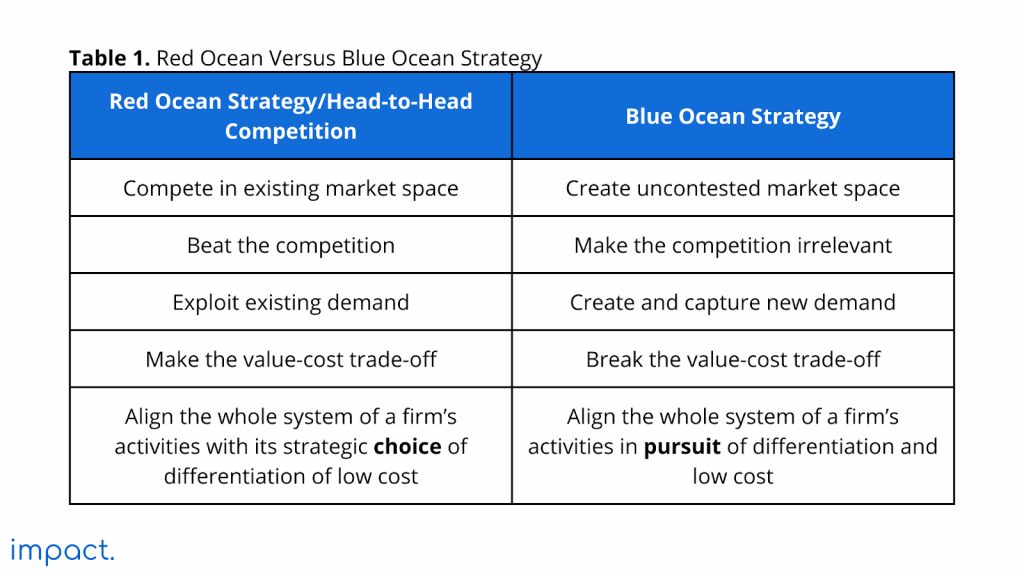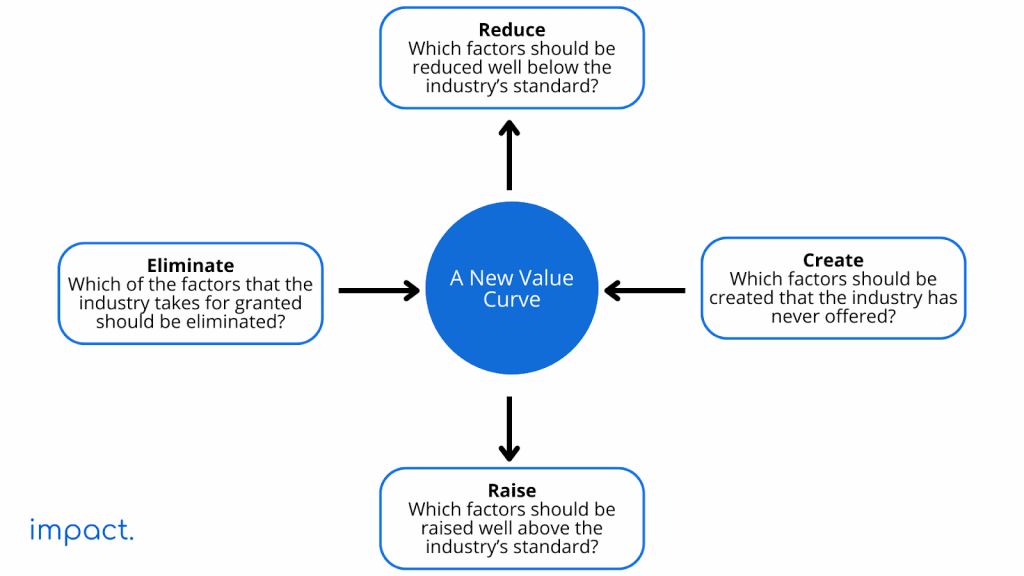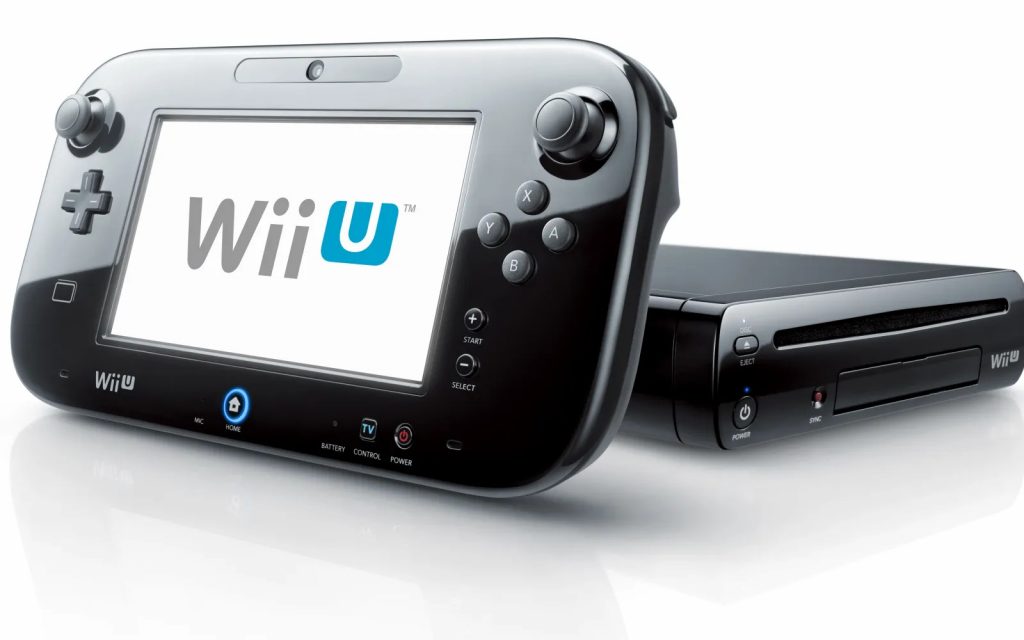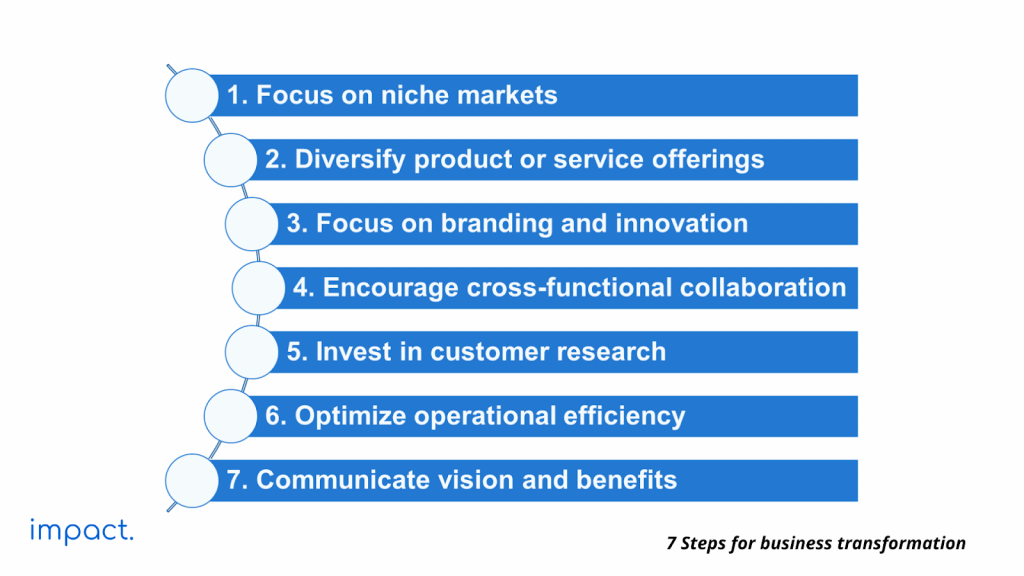Improving CRM Efficiency: 3 CRM Processes You Need to Know
As a business owner, you understand that customers keep your company going. Ensuring they are…
Sean Thobias
September 25, 2024“Blue Ocean Strategy,” by W. Chan Kim and Renée Mauborgne, is a pioneering blue ocean strategy book from Harvard Business School Press in 2005. It presents a new approach to strategy, focusing on creating “blue oceans,” untapped market spaces, where competition doesn’t matter, and businesses can excel by providing innovative and distinct value to customers.
Read more: Blue Ocean Strategy (hbr.org)
In the beginning of the book, Kim and Mauborgne talk about “red oceans,” which are tough, crowded markets where companies fight for customers. This leads to price wars and lower profits. They suggest that companies should stop competing in red oceans and instead explore new opportunities in blue oceans.
Learn more: What is Blue Ocean Strategy | About Blue Ocean Strategy
In “Blue Ocean Strategy” by Kim and Mauborgne, you’ll find practical tools, examples, and a step-by-step method for making blue oceans. They teach value innovation, where you cut costs while adding value for customers. The book highlights how being innovative in product, service, and business design can help you break away from industry norms.
Learn more: The Explainer: Blue Ocean Strategy – YouTube
A major lesson from “Blue Ocean Strategy” by Kim and Mauborgne is the significance of being different. They emphasize the value of providing unique offerings that eliminate the need for competition. Through examples like Cirque du Soleil and Nintendo Wii, the book shows how creative ideas can drive substantial growth and profits.
Learn more: Blue Ocean Strategy, Create New Markets and Leave the Competition Behind | Renée Mauborgne | WOBI – YouTube
“Blue Ocean Strategy” is a pivotal book in strategic management, urging businesses to move away from competing in crowded markets and forge new, uncontested ones. It provides a fresh perspective on achieving lasting growth and success in today’s competitive business world.
According to “Blue Ocean Strategy W. Chan Kim and Renée Mauborgne”, here are the five common challenges organizations encounter in today’s dynamic business environment:
The book discusses the challenges of competing in highly saturated and competitive markets, where companies struggle to differentiate themselves and maintain profitability.
Read more: What is Red Ocean Strategy & Why You Need to Shift to a Blue Ocean (blueoceanstrategy.com)
In fact, in highly competitive markets, companies may experience profit margins as low as 5% to 10%. Approximately 60% of businesses cite competition as a major challenge in their industry. Red ocean industries often spend around 70% of their marketing budget on price promotions.

Many businesses face the problem of limited growth opportunities due to market saturation in their industries.
In fact, market saturation can lead to a decline in revenue growth, with some industries experiencing growth rates as low as 1% to 2%. In mature markets, up to 90% of potential customers may already be using existing products or services. Identifying untapped market space can result in revenue growth of 20% to 30% or more for companies.
The book explores how companies can avoid the commoditization of their products or services, which often leads to shrinking profit margins.
In fact, in commoditized markets, profit margins can drop to as low as 1% to 3%. Commoditization can affect various industries, leading to intense price competition. Differentiation strategies can increase profit margins by 10% to 20% or more.
Companies often find it challenging to innovate within the confines of existing industry norms and practices. The book encourages breaking free from these constraints to create new value.
Approximately 67% of surveyed business leaders believe their organizations struggle with innovation due to industry norms and risk aversion. Innovative companies tend to generate 5 times the revenue growth of their peers.
“Blue Ocean Strategy W. Chan Kim and Renée Mauborgne” emphasizes the importance of understanding customer needs and creating value that resonates with them, addressing the challenge of aligning offerings with customer preferences.
In fact, customer-centric companies are 60% more profitable compared to those that are not focused on customer needs. About 84% of customers consider their experience with a company as important as the products or services they provide. Building strong customer relationships can lead to a 25% to 95% increase in customer lifetime value.
Within the domain of marketing and business strategy, “Blue Ocean Strategy W. Chan Kim and Renée Mauborgne” imparts invaluable insights and essential lessons that can reshape your approach to your undertakings. These encompass:
“Blue Ocean Strategy W. Chan Kim and Renée Mauborgne” helps companies break away from intense red ocean competition by guiding them to identify and create uncontested market space where competition is less relevant.
The book reveals that in a study of 108 companies’ product launches, creating blue oceans had a big impact on revenue and profit growth. Despite being most common at 86 percent, small improvements within existing markets only brought in 62 percent of revenues and just 39 percent of profits. In contrast, the 14 percent of launches aimed at creating new markets made a major impact, accounting for 38 percent of revenues and an impressive 61 percent of profits.
These findings underscore the substantial performance advantages of pursuing blue ocean strategies for business growth.
By focusing on differentiation and value innovation, companies can reduce competitive rivalry and enjoy higher profit margins.
The book offers a systematic approach for identifying untapped market space (blue oceans) where companies can create new demand rather than fighting over existing customers.
It provides strategies for exploring new markets, often resulting in substantial revenue growth.
“Blue Ocean Strategy W. Chan Kim and Renée Mauborgne” provides tools and frameworks to help companies escape the trap of commoditization.
In the book also, there is an explanation about the “Eliminate-Reduce-Raise-Create (ERRC) Grid”. It is a simple but powerful framework used to help businesses identify opportunities for innovation and create a blue ocean strategy. Here’s an explanation of each component of the ERRC Grid:

Figure 1. Blue ocean strategy framework.
Read more: Eliminate-Reduce-Raise-Create Grid (ERRC Grid) | Blue Ocean Strategy Tools and Frameworks
By emphasizing differentiation and value creation, companies can break free from price wars and enhance their profit margins.
The book encourages organizations to think beyond industry norms and traditional boundaries.
It offers a structured process for fostering innovation, allowing companies to create new value propositions and disrupt existing markets.
“Blue Ocean Strategy W. Chan Kim and Renée Mauborgne” emphasizes the importance of understanding customer needs and tailoring products and services accordingly.
It provides a framework for companies to become more customer-centric, leading to improved customer satisfaction, loyalty, and long-term profitability.
In the realm of marketing and business strategy, “Blue Ocean Strategy W. Chan Kim and Renée Mauborgne” provides indispensable perspectives and pivotal lessons, poised to reframe your approach across various endeavors, such as:
Cirque du Soleil revolutionized the circus industry by creating a new market space. Instead of competing head-to-head with traditional circuses in the highly competitive red ocean, they combined elements of theater and circus arts to create a unique and high-quality entertainment experience. By doing so, they attracted a different audience, reduced direct competition, and achieved higher profit margins.
In the case of Cirque du Soleil, as one of the blue ocean strategy examples, they specifically used the eliminate-reduce-raise-create grid; by:

Source: standard.co.uk, Cirque du Soleil’s new tricks.
Read more: Cirque du Soleil Case Study | Blue Ocean Strategy Example
In the mature video game console industry, Nintendo’s Wii disrupted the market by targeting a broader and more diverse audience. They introduced motion-controlled gaming, making it accessible to people of all ages and skill levels. By creating a blue ocean of non-traditional gamers, Nintendo expanded the market and achieved significant growth even in a saturated industry.

Source: 9to5toys.com, One of the Nintendo Wii products.
Read more: Nintendo Wii’s Growing Market of “Nonconsumers” (hbr.org)
Apple is known for its ability to differentiate its products in the highly competitive consumer electronics industry. They focus on design, user experience, and ecosystem integration, which sets them apart from commoditized competitors.
For example, the iPhone’s integration of hardware, software, and services created a unique value proposition that allowed Apple to maintain premium pricing and avoid commoditization.

Source: imore.com, iPhone.
Read more: Apple Differentiation Strategy | Bizfluent
Here are some actionable recommendations for business leaders or individuals based on the principles outlined in the book:

Figure 5. 7 Steps for business transformation.
Instead of competing directly with larger rivals, identify and target niche markets or underserved customer segments. Tailor your products or services to meet the unique needs of these segments, allowing you to gain a competitive edge.
Explore complementary products or services that align with your core expertise. By diversifying your offerings, you can tap into new markets or address different needs within your existing customer base, reducing reliance on a saturated market.
Invest in building a strong brand identity that sets you apart from competitors. Additionally, continually innovate by introducing new features, technologies, or services that add value and prevent your offerings from becoming commoditized.
Foster a culture of cross-functional collaboration within your organization. Encourage teams from different departments to work together on innovative projects. This can break down silos and lead to fresh ideas that challenge industry norms.
Regularly conduct in-depth customer research to understand their needs, pain points, and preferences. Use this data to tailor your products, services, and marketing efforts to meet and exceed customer expectations.
Continually assess and optimize your operational processes to reduce costs without compromising quality. Explore automation, lean practices, and supply chain improvements to find cost-saving opportunities.
Clearly communicate the vision for change within your organization. Explain the benefits and how it aligns with the long-term success of the company and the well-being of employees. Involve employees in the process and provide training and support to ease the transition.
Read also:
“Blue Ocean Strategy” by Kim and Mauborgne presents a game-changing plan for businesses and individuals in today’s complex business world. It breaks away from traditional competition and offers a clear method for carving out unexplored market territory. Using value innovation, it shows how to cut costs and boost customer value at the same time, a key strategy for lasting success.
The book highlights the need to stand out and create value by going beyond industry conventions. It uses examples like Cirque du Soleil and Nintendo Wii to show how innovative ideas can drive significant growth and profits, even in crowded markets.
Much like “Blue Ocean Strategy W. Chan Kim and Renée Mauborgne” empowers businesses to craft compelling narratives, Impact. is here to revolutionize ERP solutions for Indonesian business leaders. Designed exclusively for the dynamic Indonesian business landscape, Impact. streamlines operations and enables informed decision-making, paving the way for the future of business management. Unleash your business management’s full potential with Impact.
Read more: What is ERP?
Read also:
Impact Insight Team
Impact Insights Team is a group of professionals comprising individuals with expertise and experience in various aspects of business. Together, we are committed to providing in-depth insights and valuable understanding on a variety of business-related topics & industry trends to help companies achieve their goals.
75% of digital transformation projects fail. Take the right first step by choosing a reliable long-term partner.
